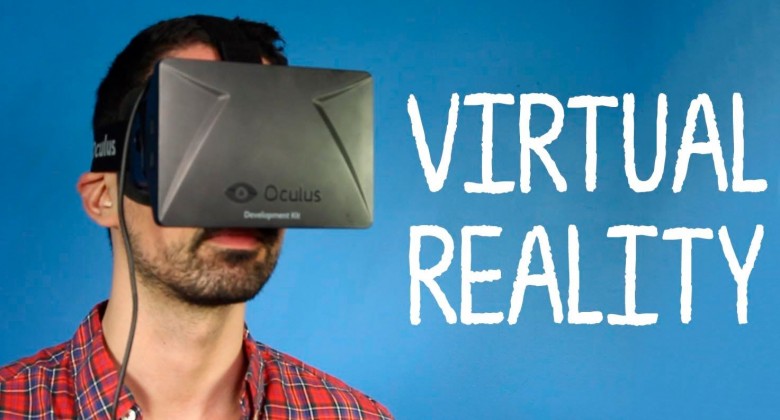Virtual Reality 101 - The Complete Guide to VR

Virtual Reality has long been a sci-fi inspired technology of the future. Writers, filmmakers, and visionaries have all imagined devices that let you interact with a virtual environment. This technology is now very much an actual reality. VR headsets have been widely available to consumers for a number of years now.
The effectiveness, immersion levels, and costs differ quite considerably. However, the technology has many different uses and an incredible amount of potential. It’s not simply an entertainment tool; it can be used in therapy, education, training, and marketing to name but a few examples. But exactly what is Virtual Reality? And how does VR work?
In this article, we’ll examine some of the key features and benefits of VR technology, as well as the practical uses it’s being applied to. We’ll also take a look at some of the main platforms the technology currently exists on, and the differences between them. Of course, we’ll cover some of the best games that are available to play, as well as what the future holds for this exciting technology. This is your ultimate guide to VR.
VR Technology is in its early stages, but the potential is huge.
What is Virtual Reality?
Virtual reality refers to computer-powered, three-dimensional environments that allow us to experience a reality that is different from our immediate one. This ‘other reality’ doesn’t necessarily have to be of a different world or time, it can be a recreation of something that already exists. For example, a VR headset user can experience the wonders of the modern world, or take a tour of a famous museum, without having to leave the comfort of their home.
For the time being, a headset of some kind is needed to experience virtual reality. Depending on the type of headset (more on that later) the user will be able to have a 360-degree view of their environment. Head and eye movements will alter perspective, and some even allow for full body movements to affect the virtual world. With some technologies, users are able to interact with and manipulate virtual objects using their movements and additional controllers.
VR Headsets allow the user to experience a simulated reality, either through a PC or mobile device.
Current VR technology is capable of convincing the visual and audio senses of the user that they’re elsewhere. One of the main points of VR is that the user should believe they’re experiencing the reality to a certain degree. Unlike a movie or computer game, looking away from the scene in front of you in VR will only alter the perspective, rather than break the immersion.
Another type of computer-generated reality is Augmented Reality. AR refers to programs or devices that display virtual information or details onto the physical scene in front of the user. This is a means of enhancing one’s current perspective of reality. AR can have many similar applications to VR, without the same level of immersion.
How Does VR Work?
So, VR is a computer-generated environment that an individual can experience and interact with. But how does virtual reality work? The most common way is to use a head mounted display or HMD. This HMD can be as simple as the Google Cardboard device. Essentially, all you need is some way to affix a display over your eyes. In Google’s case, as with many other devices, a smartphone will suffice.
More advanced and immersive HMDs have dedicated high-resolution screens. These displays are then used to simulate the visual sensation of the environment that is being generated. Usually, two autofocus lenses are placed between the screen and the eyes. These adjust based on individual eye movement and positioning. The visuals themselves are generated either by the smartphone or by an external device via an HDMI connection.
The Google Cardboard uses a smartphone and simple design to create a VR experience.
As previously mentioned, and as we’ll explore further down, there are levels of immersion when it comes to virtual reality devices. However, to create an ‘authentic’ immersive setting, there are some prerequisites needed.
Requirements for Immersive VR
-
A minimum frame rate of 60 frames per second, with a refresh rate that’s just as fast (at least 60Hz). The frame rate is the number of frames of information that are processed by the computer. Refresh rate refers to that pace at which the display can render images.
-
A minimum field of vision (FOV) of 100-degrees, with 180-degrees being preferable. The FOV is the extent to which the display can support eye and head movement.
-
Immersive sound such as 3D audio that responds to the environmental cues from the VR environment.
However, even with these technologically demanding prerequisites, we are still some distance from achieving a virtual reality that can be considered fully immersive.
Another key part of how VR systems work is related to the stereoscopic nature of the displays. This means that each eye is presented with a slightly different angle of the scene, creating a sense of depth. If this sense of depth isn’t quite right, or if the frame rate and refresh rate don’t sync up, the user may experience a level of motion sickness.
What Benefits Does VR Technology Bring?
Now that we know what VR is and how it works, it’s time to look at some of the real-life applications it has. Of course, video gaming is the thought that immediately springs to mind, and for good reason. The vast majority of VR devices are used for gaming. However, there are many more uses that the technology can be put to.
The one huge benefit is that the wearer of a VR headset can experience a location that is distant from the one they’re in. Although this is certainly fun, from a practical point of view it can be invaluable.
Imagine if you could virtually preview your holiday destination before you commit to a booking. Consider being able to demonstrate an expensive prototype to a large user base without having to actually produce it. Those who operate complicated or dangerous machinery can learn in an entirely safe environment.
Such is the power of VR. The possibilities are nearly endless. Marketing, education, and therapy can all be enhanced by using virtual and augmented reality technology. Below is an in-depth look at how VR is currently benefitting a variety of industries:
VR Tourism can allow you to experience popular destinations from the comfort of your home.
VR Benefits: PTSD Therapy
Surprisingly, there’s already a fair amount of research into VR as a tool for therapy. Over the last 20 years, there have been a number of studies on how the technology can be implemented, including for post-traumatic stress disorder. Although there need to be further controlled studies to assess the full effectiveness as a therapy, the early signs are promising. Furthermore, with the commercialization and mass market accessibility of VR headsets, it’s certainly a more viable option than ever before.
So how does VR work in a clinical setting? The most common approach is for the clinician to use the headset, in addition to other equipment, to create a setting that triggers anxiety. Although the VR setting may not perfectly replicate a real-life one, the ability for the technology to convey a sense of reality allows the patient to get used to the situation. This then allows them to confront their trauma. It’s an approach that can be used in all kinds of therapies and phobias, including fear of heights and arachnophobia.
VR can be used in a wide range of clinical settings. Image: pcmag.com
The future of VR for therapy looks promising, as the technology becomes more widely adopted. Future trials will give us a greater understanding of how VR can be best implemented in this area, and it will give greater access to important therapies.
VR Benefits: Other Therapies
Virtual Reality can also be used to enhance traditional therapies for patients with conditions including musculoskeletal problems, stroke-induced paralysis, and cognitive deficits. There are two types of VR that are used; immersive and non-immersive. The former uses an HMD in conjunction with other apparatus (such as special gloves), whilst the latter uses a screen and input device.
For stroke patients, VR can be used for task-orientated training for affected limbs. This can help the brain form new neural connections, which can stimulate the recovery of motor skills. It can also be used to improve the confidence of stroke patient. Therapists can enhance and refine the on-screen movements that the patient makes, giving them the confidence to spontaneously use their affected limbs. This spontaneous movement is crucial for recovery after a stroke.
There have been promising studies surrounding the use of VR in the rehabilitation of stroke patients. Image: saebo.com
Not only are these revolutionary technique showing early signs of promise, they could also motivate sufferers to spend more time in therapy. The VR therapies are so different from traditional methods; they can be fun and interesting.
VR Benefits: Training and Education
For jobs that are highly demanding, training is crucial. However, it’s not always safe or practical to train in a live environment. For professions in the aviation and healthcare industries, such as pilots or surgeons, virtual reality is a valuable tool for training. Pilots have long used simulations to get used to the controls in aircraft. More recently, medical schools have adopted the technology for training surgeons. It allows medical students to experience virtual flesh and bone in a safe and secure environment.
There are a number of benefits to using VR for education and training purposes:
-
It creates a realistic and immersive scenario, without the associated risks of a live situation.
-
It’s a suitable method for a wide range of learning styles and can improve retention and recall.
-
Training can be carried out remotely, in a safe and comfortable environment.
-
It’s an enjoyable and innovative way of engaging students.
-
Associated training costs can be significantly reduced, particularly if working with a prototype.
It’s clear to see just how beneficial virtual reality devices can be for training and teaching. As the technology improves, there will be wider market adoption and greater innovation.
VR Benefits: Marketing and Advertising
Immersive advertising has taken some big steps in recent years. VR as an advertising medium is still relatively new, but there have been some excellent examples of campaigns that utilize the technology. One such example is the New York Times The Displaced film. The newspaper distributed over 1 million Google Cardboard devices to their readers, who could then virtually experience the lives of three child refugees. This emotionally moving editorial film shows the power of VR as an advertising medium.
With the VR and AR markets expected to see huge growth over the next five years, the potential for advertising is evident. Once again, as more consumers adopt the technology there will be more innovations. For now, it allows businesses to promote their products, experiences, and services, remotely and with little expense. It also means that prototypes can be demonstrated and interacted with, without the need to actually produce many of them.
The virtual reality and augmented reality market is expected to see huge growth. Image: digi-capital.com
The tourism industry can also benefit from the marketing opportunities presented by virtual reality technologies. Virtual tours, previews, and other advertising techniques can be employed to entice new customers.
VR Benefits: Other Areas
So far we’ve covered some of the main areas in which VR is being utilized. These have the most traction to date, as well as some of the main areas of growth. However, there are other areas too, as we’ve briefly covered below:
-
Law. Perhaps one of the most intriguing uses for VR tech is in the law industry. As one article explores, crime scene reconstruction could soon incorporate elements of virtual reality. Crime scene footage is captured with a specially designed robot with 360-degree vision. Jurors will then be able to view this footage during a trial.
-
Property. The real estate market relies on viewings. Virtual reality headsets could soon be used to showcase homes remotely. Both realtors and potential customers could benefit from the implementation of this hardware.
-
Work. As freelancing and remote working become ever more popular, VR could offer a solution for bringing together a virtual office. Employees can work from anywhere, yet still, have a presence in the office environment through an HMD.
Virtual reality offices could soon become commonplace; ideal for freelancers and remote employees.
Virtual Reality on Different Platforms
Hardware is progressing at a rapid rate, and computing power continues to grow. As a result, devices of all kinds are now capable of creating simulated environments. There are a wide variety of devices and VR headsets that are presently available to consumers.
As we mentioned previously, the quality, cost, and performance differ greatly between platforms. Currently, the demands on processing power and graphical performance mean that the highest quality devices are fairly expensive. However, there are certainly cheaper alternatives available.
Below, we’ve detailed the different platforms that VR technology is available on. This includes price range, requirements, and capabilities.
Virtual Reality on PC
The format that dominates the space in terms of performance is on PCs and laptops. The superior processing power and graphical capabilities mean that these devices can render graphics faster, in more detail, and smoother. However, the downside for the consumer is that it comes at a great cost. Only the most powerful devices are capable of successfully running a VR system.
Below are some of the key specs you need in order to run the current generation of HMDs, as recommended by NVidia:
-
GPU: NVIDIA GeForce GTX 1060 or greater
-
CPU: Intel Core i5- 4590 equivalent or greater. For laptops, Intel Core i5-7300HQ or greater.
-
Memory/RAM: 8GB+ RAM
-
Video Output: 1x HDMI 1.4
-
Ports: 3x USB 3.0
With these specs in mind, particularly when it comes to the GPU, the cost of the system alone is around $750 minimum. You then have the cost of the headset itself, which can be a significant amount.
Below are the main VR headsets for the PC market available at the time of writing:
HTC Vive – $500
The Vive leads the way for the high-end VR market. With room-scale tracking and two motion controllers, as well as superior performance, it was leagues ahead of the Oculus Rift (below) at launch. Although this gap has narrowed recently, the Vive still represents the best option in terms of performance vs cost. The 1080p displays are of a high quality, and the room-tracking is fantastic. A more expensive Pro version is available, but it’s considerably more expensive.
The HTC Vive and Vive Pro are the most powerful VR headsets currently available. Image: vive.com
Oculus Rift- $400
The Oculus Rift was the first device to have mass market appeal, eventually leading to a $2 Billion investment from Facebook. The headset is indeed fantastic, although not quite as good as the Vive; with the room-tracking not being quite as intuitive. However, the price point is certainly more reasonable and the controllers slightly easier to use. Special mention should go to the Oculus Go, the firm’s new standalone headset. With a price of $200, it offers a level of VR immersion that comes close to the premium PC devices.
Virtual Reality on Phones
Smartphones have come a long way over the last decade. So much so that the most powerful of them are capable of running a VR experience. Of course, this experience is considerably different from the level that a PC can create. However, there are still some good and affordable options for exploring the potential of this technology. Below are some of the main headsets to consider:
Samsung Gear VR - $85
One of the best mobile headsets available at the moment is the Gear VR from Samsung. It links to your Samsung phone (provided it’s a recent enough model) and has a motion controller. There’s a wide variety of apps, games, and experiences that you can use with the device. The Gear VR offers some motion tracking, as well as a comfortable and lightweight headset.
The Samsung Gear VR offers the best value mobile virtual reality performance. Image: samsung.com
Google Daydream View - $80
Google’s answer to the Gear VR is the Daydream View. It’s a fairly capable headset that pairs with a wide variety of Android devices. However, it lacks some of the quality that the Samsung model has. In terms of price, it’s more expensive than previous models from Google, without the leap forward in quality to justify it.
Virtual Reality on Consoles
Surprisingly, the current generation of consoles hasn’t fully embraced VR tech. With the exception of Sony, there are no real options for console owners to experience virtual reality gaming. Despite the Xbox One X’s superior processing power, Microsoft has so far not released a VR headset. The portable Nintendo Switch doesn’t quite have the performance needed to power it. This means that the only console VR headset is Sony’s PlayStation VR.
PSVR - $220
Although the PlayStation VR wins by default, it’s an excellent piece of hardware. When you consider the price, even with the cost of a PlayStation 4 Pro console, it comes out significantly cheaper than the PC options currently available. It’s incredibly easy to get started with, and there’s a wide variety of titles that have already been released. The quality isn’t quite as good as the HTC Vive or Oculus Rift, but it’s still one of the best gaming experiences available in virtual reality.
The PlayStation VR headset is the only virtual reality headset currently available for consoles. Image: playstaion.com
Best VR Games Currently Available
An indication that VR gaming is the future and not just a fad is the range of excellent titles available and in the works. The market is expected to grow over the coming years, and there’s no doubt that the technology will become more widespread and accessible. We’ve highlighted some of the best titles available to play right now on a range of VR headsets:
Best Oculus Rift Game: Robo Recall
The studio behind the game Borderlands has released what is probably one of the most polished VR experiences currently available. Robo Recall is an intense yet often comical shooter. Graphically it’s impressive, whilst the gameplay is fun and intuitive. The player is tasked with recalling (destroying) malfunctioning robots with a range of upgradable weapons.
Best Multi-platform Game: Skyrim VR
Although it’s a running joke that Skyrim will soon be available on every possible device, its addition to VR is a welcome one. It is now available for Oculus Rift, HTC Vive, and PlayStation VR. The game is just as fun and engaging in VR as it was when it was originally released. Of course, it’s not a game that was designed specifically for VR, which shows at times. However, on the whole, it’s one of the best adventure games available in the medium so far.
The ubiquitous Skyrim now has a VR version, which looks fantastic. Image: steampowered.com
Best Mobile VR Game: End Space
This Samsung Gear VR exclusive is rather impressive. End Space is not a high-end PC gaming experience, but it still offers excellent visuals and fun gameplay. The player takes position in the cockpit of a spacecraft and is able to explore and dogfight their way across the vastness of space. The game has since been released on PSVR and Oculus.
Best PSVR Game: Resident Evil 7: Biohazard
The popular-yet-aging Biohazard series was reinvigorated with the release of Resident Evil 7. Although not only available in VR, it’s clear that virtual reality was a consideration during the game’s development. It’s terrifying. As you explore a creepy deserted house to find your lost wife, there are more than a few scares that await you.
Biohazard 7 offers gamers a uniquely terrifying experience. Image: steampowered.com
Best VR Games in the Works
There’s a lot to look forward to in the world of VR, not least the amount of games that are in development. Here’s a quick look at some of the most promising titles on the horizon:
Defector – Fall 2018
Defector is an Oculus exclusive, scheduled to arrive in Fall of 2018. Developer Twisted Pixel is the studio behind one of the most impressive titles available on the Oculus Rift to date, Wilson’s Heart. The trailer for this spy thriller shows excellent visuals, dramatic set-pieces, and frantic gunplay. It’s definitely one to watch.
Space Junkies – 2018
Space Junkies is a game that promises jetpacks, space, and lots of shooting. It sounds like the perfect combination, and the trailers so far seem to live up to that promise. It comes from developer Ubisoft, who have shown their VR credentials already with the popular Star Trek: Bridge Crew. The game will be available for Oculus Rift and HTC Vive.
Space Junkies VR looks like an intense and action-packed shooter. Image: steampowered.com
Ace Combat 7: Skies Unknown – 2018
If high octane flight simulators are your thing, Ace Combat 7 could be just the thing for you. The series is known for its excellent visuals, narrative, and gameplay, so VR addition is an exciting prospect. It’s unclear just how much of the experience will be specifically for VR, but the trailers so far show a lot of promise. The game will be released on PSVR.
The Future of VR
From what we’ve explored so far, it’s clear that VR is an exciting technology that is in its early stages. For many, the price of high-end equipment is prohibitive. Entry-level devices don’t quite have the quality to make the experience immersive. So is there a future for VR? The early signs are good; technology is progressing and quality is improving. What’s more, the hardware is becoming more affordable. Here are some developments you can expect in the future:
Graphical Quality Will Improve
The main barrier to fully immersive VR is the resolution of the display. As 4K resolution becomes the standard in other devices, it will only be a matter of time before virtual reality headsets reach higher resolutions. HTC’s Vive Pro already offers a 78% increase in quality over its predecessor. With advancements in computing and processing capabilities, VR’s boundaries are near limitless.
The HTC Vive Pro offers superior visuals to any other HMD. Image: vivie.com
Devices Will Be More Affordable
As Oculus have shown with their Go headset, quality VR doesn’t have to have a huge price tag. The standalone unit offers perhaps the best value for money when all things are considered. This trend is expected to continue, as more consumers adopt the technology. The quality isn’t quite there yet, but over the coming years, it will improve.
Haptic Feedback Will Be Added
Currently, most of the virtual experience is auditory and visual. However, devices such as haptic gloves will bring a tactile element to the mix. Users will be able to feel the environments they’re interacting with, getting feedback and sensations through the gloves. VR is becoming more immersive as technology develops.
Virtual Reality Roundup
Virtual Reality devices are here to stay. As we’ve demonstrated in this article, there are so many applications for the technology, even in its infancy. There are demonstrable uses where VR can benefit users across a wide range of industries. It’s not just a novelty form of entertainment. By engaging the senses, it’s possible to simulate a host of different scenarios that can be used for training, therapy, marketing, and other areas.
The hardware has progressed a lot in a short space of time, but there is definitely still room for improvement. The current cost may make the best technology an unappealing purchase, but the major players in the market are working to bring those costs down. The future will see even greater improvements across the board, as virtual reality becomes more accessible and immersive than ever before.








